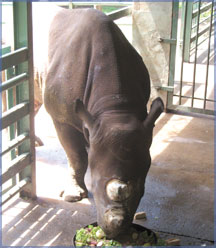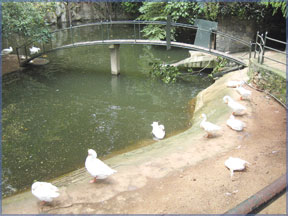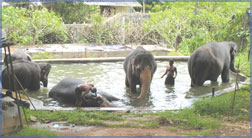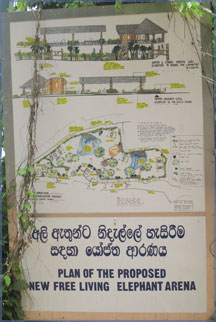A major tourist attraction
The National Zoological Gardens, Dehiwela:
by Rosanne Koelmeyer Anderson
It was the conspicuous collaboration of two brothers John Hagenbeck
and his brother Carl who was twenty two years younger than him whose
initiation gave rise to the National Zoological Gardens and what it is
today when John Hagenbeck bought two and a half acres of land at
Dehiwela and began a private animal collection centre.
|

Black Rhino, new to the zoo |
The centre was started and subsequently used by John to hold the wild
animals before exporting them to Europe , a trade he began more than
sixty eight years ago in Sri Lanka.
It was only in 1936 that the centre was taken over by the government
and today the objectives of the zoo are merely conservation ,animal
welfare, breeding research and education.
John's attraction for Sri Lanka had been since the age of twenty when
he first visited Ceylon in 1886 where he had indulged in many fields of
business.
He was a ship chandler and acquired plantations in Ceylon way back
then and grew tea, coffee and coco and incidentally the Hagenbeck name
appears on the Tiger marked tea tins even today. John , a rather
enterprising businessman at that time also indulged in catching wild
animals and was an animal trader too.

His brothers collaborated in many fields too at that time and John
later supplied his brother, Carl, with animals to do the business with
Carl Hagenbeck which stands testimony and received renowned recognition
for the foundation of the Zoological Garden in Hamburg, Germany in 1907.
John Hagenbeck's property in Ceylon was repossessed during the First
World War and John left Ceylon and returned to Colombo after the war and
founded the National Zoological Gardens of Sri Lanka at Dehiwela. He
died in an internment camp shortly after the outbreak of the Second
World War.
When the government purchased the zoo in 1936 the zoo came under the
purview of the Government Agent of Colombo and was subsequently made an
autonomous department in 1946 with the aim of satisfying the curiosity
of people and thus the zoo became more focused on entertainment and
conservation.
|

Swan Lake |
Under the patronage of the first director Aubrey Weinman cages were
built, large and small, to house an ever increasing number of specimens
and shows were introduced such as the elephant performance and
chimpanzee tea party which brought thousands of visitors to the zoo
which is still part of the entertainment today as well.
Today, the National Zoological Gardens is just 10 km away from Fort
.The 26 acre zoo is set up withbeautifully laid out shrubs, trees and
plants, orchids, lakes and fountains. At present there are 50 fish
species, 93 birds, 33 reptiles and 85 mammals to entertain the visitor
at the zoo today.
Menaka Pathirage, Zoologist ,National Zoological Gardens Dehiwela in
an interview with Sunday Observer said that there were many additions to
the zoo in the recent past; two pairs of Cheetars on August 8, 2206 from
the Singapore Zoo, a pair of white handed Gibbons or Largibbon on
October 5, 2006, White Fronted Lemurs (two males and three females) from
the Zoo de Lo-Flghe, France, a pair of Siamang Gibbons on March 5,2007
from the Ostrava Zoo, Chez Republic and Black Rhinos on July 31, 2007
from the Nagoya Hiyashiyama Zoo, Japan.

Within a month the Zoologist said there would be additions to the
zoo: two pairs of males and female Boa Constrictors, Bearded Lizards
from the Reptile Centre, England , a pair of Meerkats from the Singapore
zoo and a Greater Kudu from the Chiang Mai, Night Safari.
An exotic Bird Aviary as well as an Elephant Free Living area is in
progress, yet another attraction to the visitor. Leopard and orangutung
enclosures are also being designed, Menaka Pathirage added.

There are over 2000 animals presently in the zoo which include a
large collection of birds, elephants, sloth bears, leopards, civets, and
other small cats, many kinds of lizards, crocodiles and snakes. lions,
tigers, jaguars, black panthers, and many exotic species such as
hippopotami, rhinos, giraffes and kangaroos.

Penguins, macaws, African lions, capuchin monkeys and many endemic
species have also been reared. Recent additions to the zoo's attraction
are the museum and a live reef tank which permits visitors to observe
wildlife at close quarters. So make a trip down to the Dehiwela zoo and
explore the wonders of the much sort after tourist attraction.
In close proximity to the Dehiwela zoo is yet another tourist
attraction, the Buddhist Subodharamaya Temple, a delightful and tranquil
spot in the bustle of the suburbs which features a reclining Buddha
described as the Buddha with the Sapphire eyes.
The Dehiwela Zoo also has a great educational attraction. It is the
major zoological garden in Sri Lanka and is visited by a large number of
local and foreign tourists. Over 1.2 million visitors pass through the
Zoo's gates every year for it caters to young and old alike. Visiting
the zoo is a source of healthy recreation to the average citizen.
[email protected]
|
